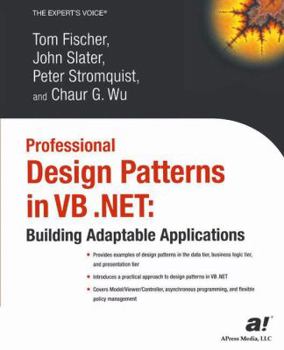Professional Design Patterns in VB .Net: Building Adaptable Applications
Select Format
Select Condition 
Book Overview
This book is not a treatment of the theory of design patterns. We show design patterns applied in real-world architectural scenarios so that you can see them in action and see the benefits that they bring. It explains why it's worth spending time building design patterns into your applications, even though this may seem at odds with Rapid Application Development.
Format:Paperback
Language:English
ISBN:1590592743
ISBN13:9781590592748
Release Date:September 2003
Publisher:Apress
Length:368 Pages
Weight:1.45 lbs.
Dimensions:0.8" x 7.5" x 9.3"
Customer Reviews
5 ratings
Design Patterns Rock
Published by Thriftbooks.com User , 19 years ago
I purchased this book a long time ago and I have to admit a lot of the information presented went right over my head in the beginning. I felt the book was too hard to understand mostly because I was still very new to .Net in general. Well, after spending a few months working on a real life project, I got the suspension that our architecture could lead to problems in the future. So I started researching design patterns and asking other people on message boards how they approach design. After all of that, I decided to review this book again and I was amazed at how much of the information was sinking in my brain this time of around. I especially love the section on applying design patterns to the data access tier. I still have more to re-read, but that is my favorite section so far. This is a great book for design pattern newbies like myself. The approaches in this book can also work in C# although some minor syntax changes would have to be made. Well worth the price.
Excellent content for Patterns
Published by Thriftbooks.com User , 20 years ago
This book illustrates, explains and simplifies design patterns. It is very easy to read, follow and understand. Although all patterns are mentioned in the book only a select few are detailed in the beginning of the book. The remainder of the book provides information how design patterns are used in the n-tier architecture, such as the data tier, middle tier and presentation tier. The books offers one of the most fascinating concepts in developing the presentation tier, called MVC, a.k.a. Model, View, Controller. MVC decouples the user interface from the form/control events on a form and placing this logic in a controller class or classes. The controllers have full control of the model aspect of the framework where the controller puts data in the view or the user interface from the model.MVC uses patterns within its framework. For example the controller is made of algorithms and therefore is a strategy pattern. The relationship between the view and model is an observer pattern, while the view is a composite and the relationship from the view to the controller is a factory pattern. Using the factory pattern the controller is created, uses the data in the model and the view is updated via the observer. The book however goes into to detail how to forgo the observer pattern by using data binding with ADO.NET and a data grid. The observer pattern in MVC is not explained, other than in the beginning of the book as the pattern itself as opposed relating to a framework.You are not limited to just these patterns within MVC. I have used the visitor pattern, the mediator pattern and the command patterns within my controller classes to achieve different methods to communicate and alter the data within the model. It is my opinion that as long as the View, the Model and the Controllers are decoupled from each other then you have achieved MVC.With excellent code and UML examples, I suggest owning this book as I find myself studying it time and time again attempting to master MVC and implementing best practice with design patterns. Another good book I highly recommend is C# Design Patterns.
Best Framework out there (even if it IS in VB)
Published by Thriftbooks.com User , 20 years ago
I was originally skeptical when a colleague suggestesd the book, since I'm a C# programmer and the title talked about business objects in VB.NET. Don't let that disuade you! With the code interoperability of .NET it doesn't matter. The code I downloaded from the website compiled first time! (Which rarely happens) and the examples touch every major angle of using the framework. For diehard C# geeks, there are user contributed ports to C#. I've been a little more open-minded in the bookstore since I bought this book. Definitely buy this book!
Classic topic that is well written for VB.NET
Published by Thriftbooks.com User , 21 years ago
Tom Fischer, et al, do a nice job explaining the basics design patterns with the newly object-oriented Visual Basic (VB.NET): which pattern is used against what type of problem. This book is great for people migrating from VB6 who have never dealt with objects and it's a good introduction to the topic. The book covers most of the original Gang of Four (GoF) models in a very readable, pragmatic way.
Easily understandable Design Patterns in VB.NET
Published by Thriftbooks.com User , 22 years ago
For those of you that hears about Design Patterns but don't know C/C++ and are having issues finding good ressources to adapt Design Patterns in the VB area, this is the book for you.Rather than attempting to compete with 'Design Patterns : elements of Reusable Object-Oriented Software', from Addison-Wesley, they extend it so that VB developers can learn how to understand design Patterns and apply them inside our applications.The book covers the following common patterns :Singleton, Abstract Factory, Factory, Adapter, Facade, Bridge, Composite, Decorator, Proxy, Observer, State, Strategy,Template.





